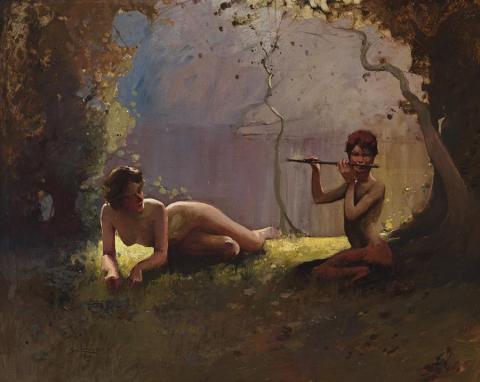FAUN AND NYMPH, 1910
Sydney Long
oil on canvas
60.0 x 75.0 cm
signed and dated lower left: SID LONG / 1910
Unknown
James R. Lawson Auctioneers, Sydney, 1976, lot 111 (cover illustration)
Private collection
Mr W.R Burge, Sydney
Deutscher Fine Art, Melbourne, 1980
Mr & Mrs E. Rogowski, Melbourne
Leonard Joel Melbourne, 23 February 1998, lot 47 as 'Fdh [sic] and Nymph'
Private collection, Melbourne
Sydney Long, S.H. Ervin Museum and Art Gallery, Sydney, 9 October – 25 November 1979, cat. 27
30 Australian Paintings, Deutscher Fine Art, Melbourne, 15 September – 3 October 1980, cat. 28 (illus.)
19th & 20th Century Australian Painting, Sculpture, and Decorative Arts 1998, Lauraine Diggins Fine Art, 1 – 27 June 1998, cat. 13
Mendelssohn, J., The Life and Work of Sydney Long, McGraw-Hill
Book Company, Sydney, 1979, p. 79, cat. 201, plate 27, p. 93 Financial Review, Sydney, 27 October 1976 (illus.)
At the beginning of the 20th century, the noonday sun gave way to moonrise, and images of noble pioneers surrendered to youthful figures inspired by Classical antiquity. A new mythology was in the air. Young people danced in Arcadian glades, fauns and nymphs peopled the Australian landscape, and the bewitching pipes of Pan were heard among the gum trees, now elegantly sinuous in the best traditions of Art Nouveau. One of the leaders of this change was Sydney Long. His 1897 oil painting The Spirit of the Plains, in the collection of the Queensland Art Gallery, captured the mood of the time in an unrivalled piece of stylish decoration. Tendril-like trunks became even more elongated in his Pan, 1898 (Art Gallery of New South Wales) in which nymphs and satyrs danced to Pan's pipe in a dusk setting - the enchanting hour of twilight when reality gives way to the imagination. A few years before, Aby Alston had painted The Golden Age (National Gallery of Victoria), with beautiful naked figures derived more from ancient Greece than the shores of Port Phillip Bay.
Similarly themed was Long's first major painting, By Tranquil Waters 1894 in the collection of the Art Gallery of New South Wales. It introduced motifs that were to continue to fascinate Long throughout the following decade, and into later periods of his art. The subject of nude figures beside still waters, for example, reappears in slightly different guise in Faun and Nymph 1910; and that of the figure playing on a reed pipe is common to both. In 1905 Long wrote that 'the Australian artist will never be able to people the bush with nymphs or the rivers with naiades, unless he invents a special Australian brand, or forgets his native landscape' [seeking] something that will better express the lonely primitive feeling of this country. A feeling more suggestive of some melancholy pastoral to be rendered in music...'1 This he achieved in Faun and Nymph. In an image evoking primordial times, he created a kind of Eden in distinctly pagan terms, the beguiling sounds of the pipe echoing the sensuous forms of the nymph and faun, which, in turn, are repeated in the melting calligraphy of the trees. Elegantly decorative arabesques of line and colour harmony are taken up by the patterns of light and shade to give the painting the resonance of an arcane melody. Pan haunts the glade in the presence of the faun, the rural deity half-human and half-animal, amorous suitor of countless nymphs. The whole is simmering with eroticism in an Arcady transferred to the Antipodes, with classical references continuing even into the planar emphasis of the composition.
1. Long, S, Art and Architecture, Sydney, January 1905, quoted in, Pearce, B. et al, Australian Art in the Art Gallery of New South Wales, Sydney, 2000, p. 85
DAVID THOMAS
